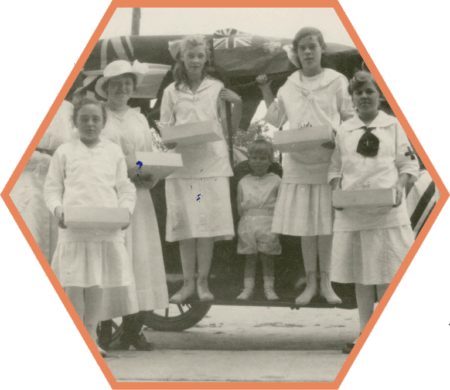Why They Became Military Nurses
Before modern times, basic patient care was typically considered a female task. Because hospitals in the mid-19th century recruited mostly poor and uneducated women to nurse, it was not seen as a vocation for respectable young women. Florence Nightingale changed all of this, inspiring women to become nurses and setting the stage for formal education and practice. Consequently, by 1905, sixty-five schools across Canada offered training programs for nurses. Unfortunately, low salaries and poor working conditions made the recruitment and the retention of nurses very difficult. Moreover, women felt pressured to leave work as soon as they got married.
1639
In 1639, the Augustine nuns arrived in Québec to establish North America’s first hospital. Eleven years later, they welcomed their first applicant born in the colony and started to provide nursing training for members of their orders. The Catholic church remained the main provider of healthcare in the Province of Quebec for centuries. (Image: Éditions de l’Hôtel-Dieu)
1854
The British government asked Florence Nightingale to train nurses for the Crimean War. In 1854, she arrived in Constantinople, only to find the military hospital in dismal condition. Her methods quickly improved the survival rate of patients. After the war, she founded the Nightingale Training School for Nurses and became a pioneer in the promotion of nursing as a profession. (Image: Wellcome Library)
1874
The first nursing school in Canada, the Mack Training School, opened in 1874 at the St. Catharines General Hospital, Ontario. It was based on Florence Nightingale’s model.
Nurses had to take the Nightingale’s Pledge at the end of their training.
(Image: Wellcome Library)
.
1885
Canadian nurses first officially took part in an armed conflict during the Northwest Rebellion (1885). Twelve Canadian Nurses also served in the Boer War in South Africa in 1899.
(Image: The Battle of Cut Knife, contemporary lithography from The Canadian Pictorial and Illustrated War News 1885)
.
1901
In 1901, the Canadian Army Medical Corps officially integrated military nurses as part of its effective strength. Canada became the first country where nurses received formal military recognition, such as rank and pay.
Image: Nurses during the Boer Wars (BAC-LAC)
The Florence Nightingale Pledge:
“I solemnly pledge myself before God and in the presence of this assembly to pass my life in purity and to practise my profession faithfully. I will abstain from whatever is deleterious and mischievous, and will not take or knowingly administer any harmful drug. I will do all in my power to maintain and elevate the standard of my profession, and will hold in confidence all personal matters committed to my keeping and all family affairs coming to my knowledge in the practice of my calling. With loyalty will I endeavour to aid the physicians in his work, and devote myself to the welfare of those committed to my care.”
Canada was the only country where, in both World Wars, the nurses were actually enrolled in the armed forces. In WWI, a Canadian Army nurse was granted the rank of Lieutenant and earned $2.00 a day (double that of a Private in the trenches), whereas a nurse at the Montreal General Hospital would typically earn less than $0.50 cents a day.
Multiple Identities
In the early 1900’s, the role of women in society was shifting. Since all of the nurses were women, and almost all were single, a number of tropes developed portraying nurses as saintly, matronly, or in idyllic ways. These tropes were perpetuated by the patients who were grateful for the caregiving they received. Their courage and compassion was admired by many of the soldiers who affectionately nicknamed them “Sisters of Mercy” or “Angels of Mercy”. The Nursing Sisters, also known as “bluebirds” because of the colour of their uniforms, returned to Canada with a sense of pride and greater clarification of their role. A memorial to the nursing sisters of the First World War was erected in Ottawa in 1926 in the Hall of Honour in the Parliament of Canada.
Close to the front, at the Casualty Clearing Stations, the only women present were the nurses. The wounded soldiers found in the nurses individuals to whom they could confide their fears and hopes, and from whom they received emotional and moral support. Many families were comforted by the letters that the nurses wrote on behalf of the wounded in their final days. Nurses volunteered for service out of patriotism and a desire to fulfill their roles as caregivers. They may not have supported the concept of war, but, as in any disaster, they saw the need to be there to care for the victims of this conflict.
Canadian nurses, unlike those from other countries, were under the direct control of the army and held the military rank of Lieutenant. Women who volunteered served under many banners. Some were trained professionals, like the Nursing Sisters, and others had limited training, such as the VAD’s (Voluntary Aid Detachments). Some were enlisted in the Armed Services, while others were attached to organizations, such as the Red Cross. Coordination of all their efforts to work as a team was no doubt a difficult and trying experience.
 Social activities were limited by the surroundings and circumstances. With the rank of Lieutenant, Canadian Nursing Sisters in uniform could only socialize with officers, while British nurses, on the other hand, could only socialize with the rank and file. The nurses at stationary hospitals organized various social events for the soldiers, but fraternization was not encouraged outside work or these events. Regulations relating to marriage and home leave were different for the nurses and the soldiers. Women could be given permission to return home to care for family issues, while the men were obliged to remain at the front.
Social activities were limited by the surroundings and circumstances. With the rank of Lieutenant, Canadian Nursing Sisters in uniform could only socialize with officers, while British nurses, on the other hand, could only socialize with the rank and file. The nurses at stationary hospitals organized various social events for the soldiers, but fraternization was not encouraged outside work or these events. Regulations relating to marriage and home leave were different for the nurses and the soldiers. Women could be given permission to return home to care for family issues, while the men were obliged to remain at the front.




